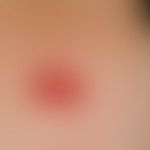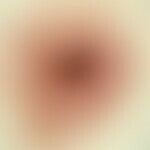Synonym(s)
DefinitionThis section has been translated automatically.
Basal cell carcinoma characterized by a painless, sharply defined, almost crater-shaped ulcer (as carved out) with a raised marginal wall, which has arisen from a nodular basal cell carcinoma by central decay.
Occurrence/EpidemiologyThis section has been translated automatically.
The statements made here refer to the diagnosis"basal cell carcinoma" in general. No reliable epidemiological data are available for the subtypes.
Most common skin carcinoma among the Caucasian population (red-haired people have a higher risk than brown-haired people).
Incidence rates are missing for most European countries. In Germany the incidence is about 100/100,000 inhabitants/year. Known data indicate the highest incidence in Wales (112/100,000 inhabitants/year) and the lowest in Finland (49/100,000 inhabitants/year).
Men and women are equally affected.
People with actinic cheilitis and solar lentigines have a higher risk of developing basal cell carcinoma.
Only very rarely does metastasis occur (less frequently than 1:1000). In North America the incidence in the population < 40 years is higher in women than in men.
Multiplicative factors (e.g. anamnestic sunburns, sun exposure) play a role in the development.
You might also be interested in
EtiopathogenesisThis section has been translated automatically.
S.u. basal cell carcinoma
ManifestationThis section has been translated automatically.
S.u. basal cell carcinoma
LocalizationThis section has been translated automatically.
face, forehead, nose, cheek, auricle, bald head
Clinical featuresThis section has been translated automatically.
- Sharply defined, such as excised, painless, round or oval ulcer with clean wound base covered with crusts or red granulations, steeply sloping edges. The size of the ulcer depends on the duration of "non-treatment" and varies between 0.4-2.0 cm in diameter.
- Diagnostically important is the assessment of the peripheral area of the ulcer. This consists of a (pearl-like) marginal wall with shiny white papules which emerges when the surrounding healthy skin is stretched (this marginal wall, consisting of linearly arranged nodules, is highly typical for this basal cell carcinoma and can be removed especially under good, oblique illumination). With a 10x magnifying glass, bizarre small vessel lines can be detected on the edge wall, which show quite irregular calibre fluctuations (pathological tumour vessels, see below: basal cell carcinoma nodular).
DiagnosisThis section has been translated automatically.
The diagnosis of an "atypical ulcer" is consolidated by the following constellation of symptoms:
- Previous nodulation
- Atypically long duration of stock (>6 weeks)
- Painlessness
- Atypical localization (for a banal ulcer)
- Atypical structure with border wall
The diagnosis is saved by a biopsy from the marginal area! No need to take healthy surrounding skin with you!
TherapyThis section has been translated automatically.
LiteratureThis section has been translated automatically.
- Mc Cormack et al (1997) Differences in ages and body site distribution of the histological subtypes of basal cell carcinoma. Arch Dermatol 133: 593-596
- Peris K et al (2005) Imiquimod treatment of superficial and nodular basal cell carcinoma: 12-week open-label trial. Dermatol Surgery 31: 318-323
Incoming links (1)
Ulcer rodening;Disclaimer
Please ask your physician for a reliable diagnosis. This website is only meant as a reference.



















